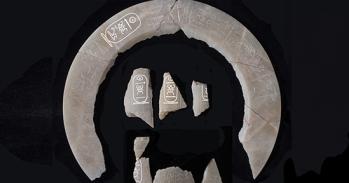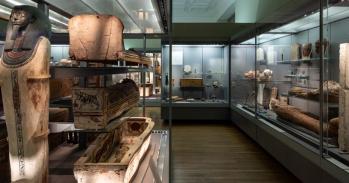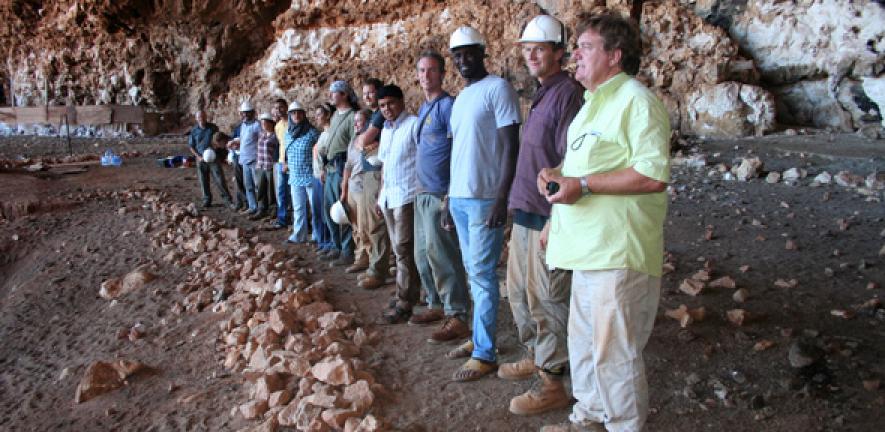
With Daesh militia at their heels, a handful of brave Libyan archaeologists completed the excavation of the Haua Fteah cave in Cyrenaica, North Africa. Cambridge archaeologist Dr Giulio Lucarini tells their story.
With Daesh militia at their heels, a handful of brave Libyan archaeologists completed the excavation of the Haua Fteah cave in Cyrenaica, North Africa. Cambridge archaeologist Dr Giulio Lucarini tells their story.
“We can do it ourselves,” said Ahmad Saad Emrage, archaeologist at the University of Benghazi. “We can still work safely enough. We will be accurate and fast.”
True heroes, generous hearts: these are the Libyan archaeologists who, with Daesh at their heels, have accomplished the feat of completing the excavation of the Haua Fteah cave in Cyrenaica, one of the most important prehistoric sites of all Africa. When, in 2013, the team of international researchers involved at the site was forced to suspend work, nine Libyan archeologists - two women and seven men - successfully completed the excavation by themselves, securing its secrets for posterity. Thus the history of human population along the North African coast over the last 100 thousand years can now be written.
Haua Fteah is, in fact, the largest karst cave in the Mediterranean (measuring 80 x 20 metres) and is open to the sea a short distance from the city of Susa, the ancient Apollonia. It is a sort of natural hangar, inhabited uninterruptedly by humans from prehistoric times until the present. Investigated for the first time between 1951 and 1955 by Charles McBurney - an archaeologist from the University of Cambridge - the same university resumed the research in 2007 under the direction of Professor Graeme Barker, in collaboration with the Libyan Department of Antiquities and an international team of scholars, including myself.
Beginning at the earliest levels, at about 15 meters below the current surface and relating to the Middle Palaeolithic, the cave takes us on a breathtaking journey through time. We first move through the levels dating back to 70,000 years ago where the only human remains found so far at the site - two fragments of Homo sapiens lower jaw - were uncovered: a moving testimony to the arrival of our ancestors along the North African coast. We can then examine the layers of the Upper Paleolithic on our way to the Neolithic, when the first species of domesticated animals and plants of the Levantine regions made their appearance in North Africa. Continuing our journey towards the surface, through layers dating from the Classical Period and thence more recent ones, we arrive at the present day. Like a wonderful freeze frame which has lasted thousands of years, the cave is still in use to this very day - as a livestock shelter - by families of shepherds. It is greatly respected by the local population.
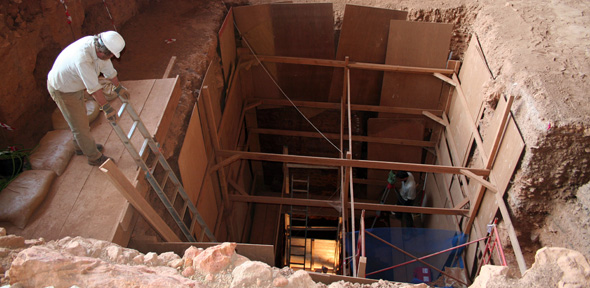
Despite the instability that has followed the collapse, in 2011, of the Gaddafi regime in Libya, we continued to work at Haua Fteah - albeit with considerable difficulty - until September 2012 when the US Ambassador to Libya, Chris Stevens, was assassinated in Benghazi. The terrible news reached us while we were actually digging in the cave. We were struck by a deep sense of loss, but also with concern for our own safety. We left Libya a few days later and, after months of indecision and another very brief campaign in 2013, Graeme Barker reluctantly decided to suspend the excavation. Daesh had definitively taken control of the city of Derna, just 60 kilometers east of Haua Fteah, and the risk to our safety was really too great.
However, our Libyan colleagues continued to monitor the massive open trench, and a short while later they informed us that its walls, exposed since 2007, were not going to last for long. To safeguard and bring to a conclusion the work of years, the excavation had to be completed as soon as possible. “We can do it ourselves,” said Ahmad Saad Emrage, archaeologist at the University of Benghazi. “We can still work safely enough. We will be accurate and fast.” So, without any delay, the ‘command’ of operations fell to Ahmad and his team of local archaeologists: Fadl Abdulazeez, Akram Alwarfalli, Moataaz Azwai, Saad Buyadem, Badr Shamata, Asma Sulaiman, Reema Sulaiman and Aiman Alareefi.
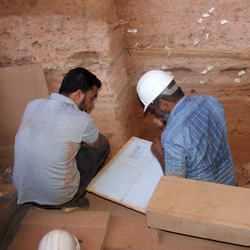
Who are these ‘Fantastic 9’? They are, first and foremost, passionate archaeologists and serious professionals. Ahmad and Fadl are the ‘fathers’ of the group, always ready to guide and encourage the younger ones; then there is Moataz, the tireless ‘gentle giant’; then two young daredevils, Akram and Saad, who, after a day of excavation, love to dive from the beautiful cliffs of Lathrun; also Badr and Aiman, who make sure the rest of the troop always has tea in their cups and sheesha to puff on; and then the two sisters, Aasma and Reema, who have iron will. Nine different individuals, nine different histories, united by an immense passion for their homeland, Libya, and by a single unwavering desire: to save their country and its history.
The first excavation campaign began on May 9th 2015 and was supposed to last for two months, but it was suspended after only four weeks. Ahmad told me that “after work started with no particular problem, the situation had rapidly deteriorated. Local sources had reported to us that Daesh militants had recently been seen in the Susa area. When passing through the town we would often hear gunfire and screams. We were afraid, but we did not want to stop. During the raids against the Daesh positions in Derna, Libyan air force planes and helicopters flew over the cave. We were by no means certain that they were all aware of our presence in the area, and, for fear of being mistaken for terrorists, we would run to take shelter in the back of the cave every time we heard the noise of an approaching aircraft. I remember one day when I was carrying the long plastic tube we used to store the stratigraphy drawings of the excavation over my shoulder; on hearing the sound of an approaching helicopter, Fadl grabbed the tube and threw it away from us, for fear it could be mistaken for a rocket launcher. We were extremely tense, and when the helicopter finally moved away, we looked at each other and burst into laughter.”
“We were increasingly afraid but we continued to work. One day, however, a friend came running, shouting that the night before he had seen masked men in the vicinity of the cave, almost certainly Daesh militiamen. And shortly afterwards the Susa police arrived and forced us to stop work. It was not easy to convince the boys that we could not go on. ‘We can still do it - they kept repeating – we’ll be even more careful and fast’. Reluctantly, however, we collected the equipment and left the cave.”
But that was not the end by any means. Two months later, thanks to the liberation of Derna from Daesh militia, the 'Fantastic 9' returned to the cave and finally managed to complete the excavation. “Do not call us heroes,” Ahmad exclaimed when I told him that I would recount their adventure. “We just did what had to be done, as archaeologists and as Libyans.” However, in a country like Libya that sees its archaeological heritage so dramatically at risk, our colleagues’ achievement was exceptional in its significance: it showed that the Libyans have not given up, that they wish to reclaim their own cultural heritage and determine its fate themselves.
Inset images: Top: the Haua Fteah trench (credit: Cyrenaica Prehistory Project). Bottom: Saad Buyadem and Fadl Abdulazeez (credit: Cyrenaica Prehistory Project).
Dr Giulio Lucarini is a Leverhulme Research Fellow at the McDonald Institute for Archaeological Research in Cambridge. Excavation at Haua Fteah has been principally funded by the European Research Council, with supplementary funding from the Society of Libyan Studies, the project’s sponsor.
This article was first published in Archeostorie. Journal of Public Archaeology.

The text in this work is licensed under a Creative Commons Attribution 4.0 International License. For image use please see separate credits above.


